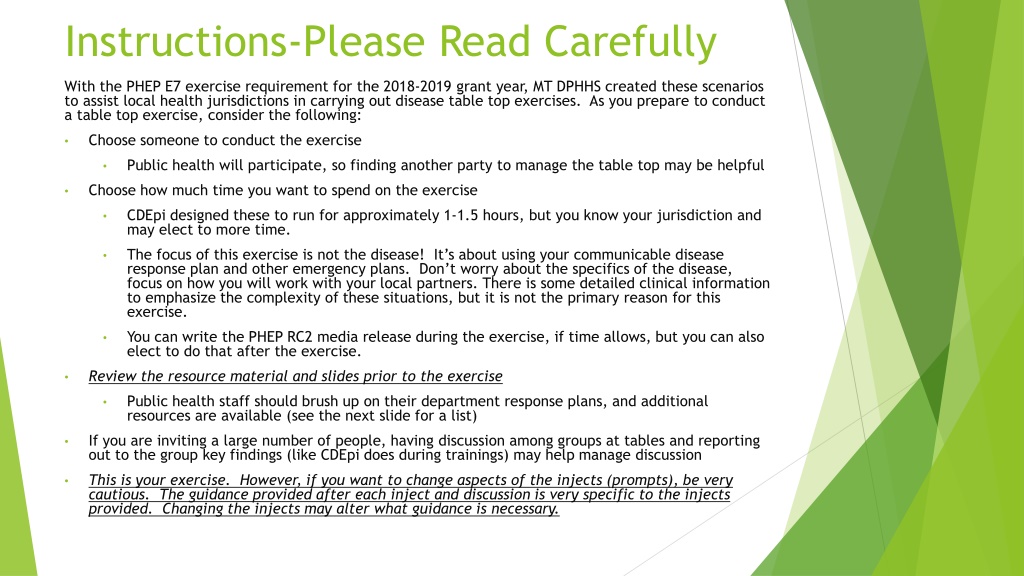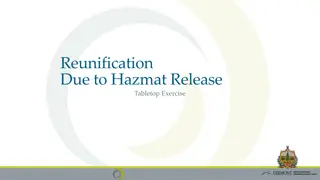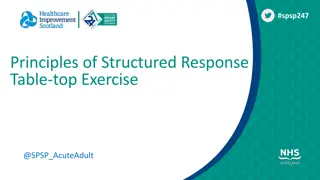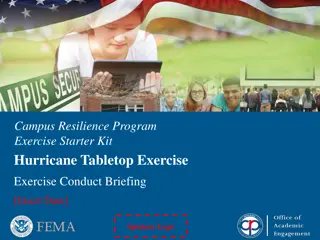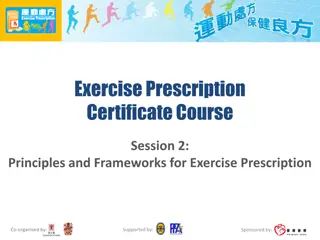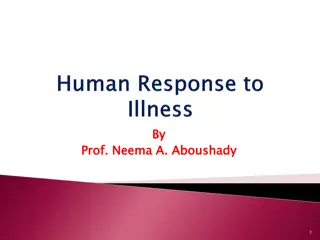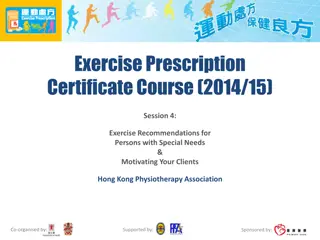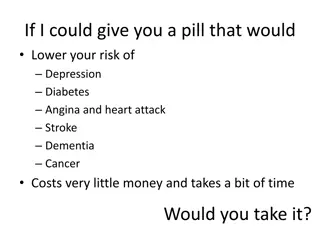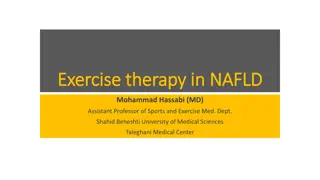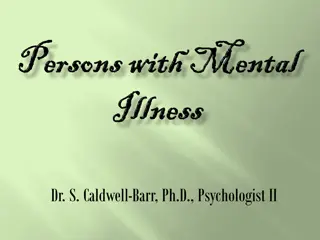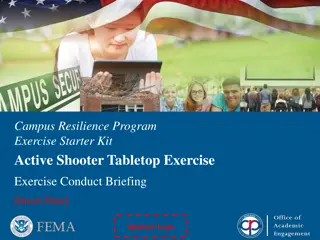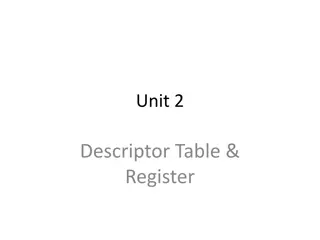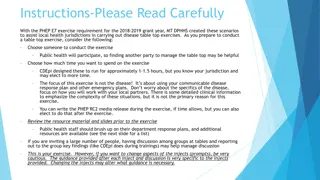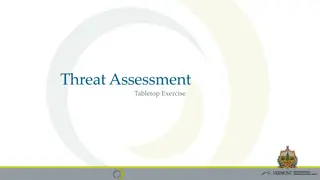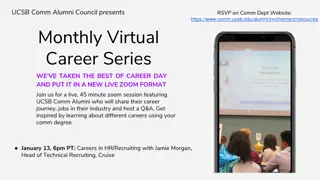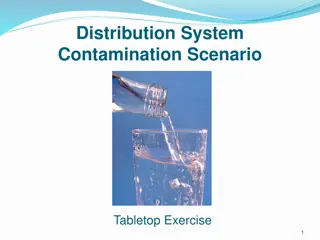Comm Disease Table Top Exercise: Diarrheal Illness Response Plan
MT DPHHS developed scenarios to aid in disease table top exercises. Local health jurisdictions are guided on using public health emergency response plans effectively. The focus is on response strategies rather than the disease itself. Resources and objectives are provided to enhance exercise outcomes and strengthen emergency preparedness plans.
Download Presentation

Please find below an Image/Link to download the presentation.
The content on the website is provided AS IS for your information and personal use only. It may not be sold, licensed, or shared on other websites without obtaining consent from the author. Download presentation by click this link. If you encounter any issues during the download, it is possible that the publisher has removed the file from their server.
E N D
Presentation Transcript
Instructions-Please Read Carefully With the PHEP E7 exercise requirement for the 2018-2019 grant year, MT DPHHS created these scenarios to assist local health jurisdictions in carrying out disease table top exercises. As you prepare to conduct a table top exercise, consider the following: Choose someone to conduct the exercise Public health will participate, so finding another party to manage the table top may be helpful Choose how much time you want to spend on the exercise CDEpi designed these to run for approximately 1-1.5 hours, but you know your jurisdiction and may elect to more time. The focus of this exercise is not the disease! It s about using your communicable disease response plan and other emergency plans. Don t worry about the specifics of the disease, focus on how you will work with your local partners. There is some detailed clinical information to emphasize the complexity of these situations, but it is not the primary reason for this exercise. You can write the PHEP RC2 media release during the exercise, if time allows, but you can also elect to do that after the exercise. Review the resource material and slides prior to the exercise Public health staff should brush up on their department response plans, and additional resources are available (see the next slide for a list) If you are inviting a large number of people, having discussion among groups at tables and reporting out to the group key findings (like CDEpi does during trainings) may help manage discussion This is your exercise. However, if you want to change aspects of the injects (prompts), be very cautious. The guidance provided after each inject and discussion is very specific to the injects provided. Changing the injects may alter what guidance is necessary.
Resources-Review Montana Code Annotated Title 50-1-102 General Powers and Duties Montana Code Annotated Title 50-16-601 to 611 Government Health Care Information Act Montana Code Annotated Title 50, Chapter 2, Local Boards of Health Administrative Rules of Montana, 37. 114.101 to 1016 Control of Communicable Disease Manual (CCDM) adopted by reference in ARM 37.114.201(2) Guidelines for Isolation Precautions in Hospitals. Adopted by reference in ARM 37.114.101(9) GI Outbreak Investigation Guidelines from MT DPHHS found at https://dphhs.mt.gov/Portals/85/publichealth/documents/CDEpi/CDCPBResourc es/DiseaseForms/GastroenteritisOutbreakInvestigationGuidelines.pdf See the Epi Resource Page for examples of messaging and other materials.
Communicable Disease Table Top Exercise Diarrheal Illness in a Food Handler
Objectives 1. Exercise activation of the local health jurisdiction public health emergency response plans: Activation of emergency response operations a) Case confirmation b) Laboratory testing considerations with emergency specimen transport c) Mandatory exclusion of susceptible populations or enforcement of public health law d) Public health management of contacts e) Communication with public and response partners f) 2. Engage local public health partners in an exercise to clarify roles in response. 3. Identify gaps and strengths in emergency preparedness plans: Public health a) Coordinating response plans with partners (hospital preparedness, DES, etc.) b)
Why is DPHHS asking us to conduct this exercise? In 2016, local health jurisdictions were asked how prepared they were to respond to a communicable disease event: About two-thirds of jurisdictions did not feel prepared to enact non-pharmaceutical interventions (steps taken that may include isolation or quarantine) when necessary About one-third of jurisdictions did not feel fully prepared to perform communicable disease surveillance and investigation activities Gaps were identified in real-life disease events in the past two years
A few things to consider This scenario is designed to test your local response to a suspect or confirmed public health threat. Artificialities may occur depending on your jurisdiction s size and resources. The time it will take to run this exercise will vary depending on your assembled team. Format: INFORMATION bulleted in green QUESTIONS/DISCUSSION POINTS bulleted in red Stop the slides when you see red, and the answers or guidance information will be on the following slide or slides. ANSWERS bulleted in blue and italicized
Partners and Applicable Plans RECOMMENDED PARTNERS IN THIS EXERCISE: APPLICABLE PUBLIC HEALTH PLANS/ANNEXES/STANDARD OPERATING PROCEDURES LOCAL HEALTH OFFICER LEAD LOCAL HEALTH OFFICIAL ALL-HAZARDS PLAN LOCAL COUNTY ATTORNEY (IF POSSIBLE) COMMUNICABLE DISEASE RESPONSE PLAN BOARD OF HEALTH MEMBERS PUBLIC HEALTH COMMUNICABLE DISEASE STAFF NON-PHARMACEUTICAL INTERVENTIONS PLAN (MAY BE TITLED AN ISOLATION AND QUARANTINE PLAN) INFECTION PREVENTIONIST/INFECTION CONTROL STAFF FROM LOCAL HOSPITAL(S) HEALTHCARE PROVIDER (IF POSSIBLE) LABORATORY SAMPLE TRANSPORT PLAN LABORATORY PERSONNEL SCHOOL ADMINISTRATORS AND NURSES HEALTH ALERT NETWORK (HAN) PLAN OTHER LOCAL PARTNERS YOU WISH TO INCLUDE, SUCH AS DISASTER AND EMERGENCY SERVICES STAFF RISK COMMUNICATION POLICIES AND/OR CRISIS AND EMERGENCY RISK COMMUNCATION PLAN
Scenario A provider at your local hospital contacts the local health department to report a number of individuals presenting to the ER with severe diarrhea, fever, and dehydration. A number of the individuals report eating at a local food establishment within the previous week. What questions would you ask the provider during that call? What information would you like to obtain for your case investigation? Suggested discussion length-5 mins
Gather information Ask the caller for: Demographic and contact information of the cases; What signs and symptoms were reported; Any test results for the ill individuals; Name of establishment that is suspected as a source; Dates they dined there Any cases that have a sensitive occupation; Let the caller know public health will look into the cases, but may have to call back for more information.
Initial findings Six individuals are reported to you having similar signs and symptoms over the last two days, including two children. Symptoms include fever, vomiting, diarrhea, and dehydration. Testing is pending but was ordered for all six. One individual >65 years is currently hospitalized. One family group (3 cases) reported eating at a local fast-food restaurant. Other patients were not asked that question. What is your next step? Suggested discussion length- 2-3 mins
Gather information 2.0 Ask for lab results What are the onset dates? Determine if there was any travel prior to onset Is anyone else similarly ill? Where are they? Determine if any patients are in a sensitive setting: Employment: food handler, health care worker, day care worker Attends daycare Lives in nursing home
The provider suspects the following conditions based on presentation: Campylobacteriosis Salmonellosis Norovirus
Common enteric diseases: Signs and Symptoms Disease Causative agent Campylobacteriosis Campylobacter Salmonellosis Salmonella Norovirus Norovirus Reservoir Cattle, poultry Poultry, reptiles Humans Transmission Fecal-oral Fecal-oral Fecal-oral Incubation period 1-10 days (avg 2-5) 6-72 hours (avg 12-36) 10-50 hours Fever Yes Yes No Malaise Yes No Yes Abdominal pain Yes Yes Yes Vomiting Sometimes Yes Yes Diarrhea Yes Yes Yes Duration 2-5 days 4-7 days 1-3 days
Assess what you have so far The provider notified local public health of the suspected outbreak, who should now be notified by local public health? Local health officer? Local health board? CDEpi? Will you activate your Epi Team at this time? Who is on it and what is their role? Guidance for this will be in your communicable disease response plan specific to your jurisdiction. What control measures are needed at this time without knowing the exact cause of the diarrhea? Suggested discussion time-5 mins
Pubic Health Notification In this scenario, public health is involved from the beginning. In other incidents involving communicable disease, notification should happen early in the process. Call public health via your local 24/7 number immediately when a reportable condition is suspected or confirmed. If you cannot reach your local public health office, you may call CDEpi at our 24/7 number (406-444-0273). Public health can provide: Guidance on confirmatory testing and DNA fingerprinting Public health case management, identification of new cases, and control measures Guidance on public messaging CDC consults, when requested Depending on the situation, other resources are available too.
Initial Control Measures A reportable condition exists in this scenario (Immediately reportable from local health partners to the local health jurisdiction): 37.114.203 REPORTABLE DISEASES AND CONDITIONS (1) The following communicable diseases and conditions are reportable: (t) Gastroenteritis outbreak; Additionally, the reporting timeline of suspected GI outbreaks are outlined in ARM for local public health. 37.114.204 REPORTS AND REPORT DEADLINES (Reporting timeline for the local health department to DPHHS) (2) A local health officer must transmit by telephone or secure electronic means to the department the information required by ARM 37.114.205(1) and (2) for each suspected or confirmed case of one of the following diseases, within the time limit noted for each: Information about a case of one of the following diseases should be submitted within 24 hours after it is received by the local health officer: (a) (v) Gastroenteritis outbreak; Since we do not know anything about the cases job or daycare status, this would be a good time to: Provide basic hygiene and handwashing education Once you contact the symptomatic individuals, ask if they are a food handler, work directly with at-risk populations, attend daycare, or are otherwise involved with sensitive populations.
Laboratory Testing The provider ordered a GI panel for Salmonella species, and it was positive. What additional testing is needed? How quickly can you obtain results?
Laboratory testing Culture is the gold standard for confirming enteric diseases Testing available from the Montana Public Health Laboratory: If we grow the organism, we can perform DNA fingerprinting to link cases In this situation, it s important to determine if the cases are linked by laboratory analyses, which is only available from MTPHL. Specimens are also required to be sent to MTPHL by this ARM: 37.114.313 CONFIRMATION OF DISEASE Subject to the limitation in (2), if a local health officer receives information about a case of any of the following diseases, the officer must ensure that a specimen from the case is submitted to the department, when possible, which will be analyzed to confirm the existence or absence of the disease in question, or for use in surveillance: (v) Salmonellosis (2) In the event of an outbreak of an arboviral disease, gastroenteritis, influenza, measles, or pertussis, specimens must be submitted until a representative sample has been reached as determined by the department. (3) A laboratory professional or any other person in possession of a specimen from a case of a disease listed in (1)(a) through (ag) must submit the specimen to the department upon request. (4) If no specimen from the case is otherwise available and the case refuses to allow a specimen to be taken for purposes of (1), the case will be assumed to be infected and must comply with whatever control measures are imposed by the department, or the local health officer.
Laboratory Testing The courier system for MTPHL is down and it is not clear when the service will be back up again. According to your local laboratory sample transport plan, what do you do?
Laboratory Sample Transport Plan All local health jurisdictions are required to maintain a plan specific to their resources in order to send samples to MTPHL on an emergent basis: Laboratory Sample Transport Plan (LSTP) Work with CDEpi by dialing 406-444-0273, and we will help coordinate sample testing and arrival at MTPHL during a case investigation Advice on packaging, forms, sample handling are also available from MTPHL
Testing Results The appropriate specimen is sent to MTPHL and testing confirms out for Salmonella for all 6 cases. DNA fingerprinting is pending. What are your next steps?
Assess what you have now Determine who needs necessary exclusions Activate EPI Team if you haven t done so already Messaging Reporting Monitor for new cases
Messaging Think about the messaging that needs to be performed between public health, the hospital, and the local response partners: Local partners-what information do you need from public health? Public health-what do your communicable disease response, risk communications, and Health Alert Network (HAN) plans say you should do?
Messaging to Public Health and their Partners A HAN message is recommended to local partners Those who feel they have been exposed when word circulates about Salmonella outbreak may appear at healthcare providers offices for testing Information regarding Salmonella can be distributed quickly to healthcare providers Action steps for partners can be given if potential cases are identified, and how to manage the worried-well Can use a HAN to institute increased active surveillance with your local partners Identify a route to manage the reports as they come in
Exclusions One of the cases (5 years old) attends daycare What exclusions are warranted in this situation? When can the patient return to daycare?
Exclusions Daycare rules (ARM 37.95.139) mandate exclusion until symptoms have resolved AND 2 negative stool specimens are obtained before returning to daycare: 37.95.139(3b) Children must be without vomiting and diarrhea for 24 hours before they return to the day care facility. Vomiting includes two or more episodes in the previous 24 hours. Diarrhea is defined as an increased number of stools, increased water in the stool, and/or decreased form to the stool that cannot be contained by a diaper or clothing; 37.95.139(7a) If a child is excluded for shigellosis or salmonella, the child may not be readmitted until the child has no diarrhea or fever, the child's parent or guardian produces documentation that two stools, taken at least 24 hours apart, are negative for shigellosis or salmonella, and the local health authority has given written approval for the child to be readmitted to the day care facility;
Emergency Response Plans Would you activate your public health emergency plans? Which ones? This will be specific to your jurisdiction, so refer to your health department emergency operations plans for guidance.
Outbreak Investigation Who is a case, and how will you identify them? For reported cases, what information do you need to find the source of the outbreak: Was there travel? Food history? Animal exposures? Suggested discussion time-5 mins
Outbreak Investigation Public health and their partners at this time should cast a wide net looking for cases through public health active surveillance Healthcare partners-report to local public health individuals with consistent signs and symptoms Environmental staff-share complaints that may have been reported to the sanitarians Communications personnel can monitor social media Look for cases connected to exposure to your known cases (close contacts) More information is now available: No additional cases are reported in household contacts of cases No cases reported travel outside of the county Questionnaires are in progress for detailed food history Two cases report animal exposures (pet turtles)
New Information Interview with cases determines that the majority ate at the same fast food restaurant within the 3-5 days before onset of symptoms. Complete food histories are not available yet but so far, no single food product is implicated Your sanitarian visits the restaurant and interviews the manager and several employees. One employee reports having mild gastrointestinal symptoms since the previous week, and has been working through that time o His job is to wash and prepare vegetables for salads What are your next steps?
Control measures General control measures for food handlers: Education on food safety/preparation Reassign workers to alternate duties to maintain work hours Exclusion Typically in a setting where other individuals would not be safe from acquiring disease Consult with CDEpi prior to exclusion decisions Education Handwashing When to stay home
Sick Food Handlers This food handler currently has symptoms of diarrheal illness, and cannot be allowed to handle food ARM 37.114.301 SENSITIVE OCCUPATIONS AND SETTINGS (1) A local health officer or the department may restrict a person employed or engaged in direct care of children, the elderly, or individuals who are otherwise at a high risk for disease from practicing an occupation or activity while infected by a reportable disease if, given the means of transmission of the disease in question, the nature of the person's work would tend to transmit the disease. (2) No infectious person may engage in any occupation or activity involving the preparation, serving, or handling of food, including milk, to be consumed by others than their immediate family, until a local health officer determines them to be free of the infectious agent or unlikely to transmit the infectious agent due to the nature of their particular work. (3) Persons involved in food preparation, serving, or handling of food may be subject to additional restrictions as specified in: "Food Code, 2013, Recommendations of the United States Public Health Service, Food and Drug Administration" published by National Technical Information Service, Publication PB2013-110462, ISBN 978-1-935239-02-4, November 3, 2013. (4) Persons attending or residing in congregate settings may be subject to additional restrictions and exclusions to prevent further transmission as determined by the local health authority.
Sick Food Handlers Control measures for salmonella are outlined in the CCDM and in FDA 37.114.501 MINIMAL CONTROL MEASURES (1) The department, except as otherwise provided in this subchapter, adopts and incorporates by reference the control measures in the "Control of Communicable Diseases Manual, An Official Report of the American Public Health Association" (20th edition, 2015). Unless a particular control measure specifies who is responsible, the local health officer or the authorized representative of a local health officer must: (a) employ the minimum control measures; or (b) ensure that minimal control measures are employed by a health care provider or other person caring for a person with a reportable disease. In this situation, requesting assessment of the food handler for Salmonella infection is indicated.
New Information Of the 6 original cases identified through outbreak investigation: The daycare attendee remained at home until 2 negative stools were confirmed by pediatrician One patient worked in a nursing home, so they were given an alternate work assignment that did not involve patient care until 2 negative stools were confirmed Public health restricted the staff member at the restaurant from handling food while having diarrhea, and to submit a stool specimen for Salmonella testing. The specimen was confirmed to have Salmonella species present bringing the total case count to 7. These cases are not typhoid fever, but another Salmonella species. What are your next steps?
Mandatory Exclusion How you enact an exclusion for food workers depends on your local plans and resources. Consider whether you would issue a written order for exclusion from a sensitive setting. You must maintain privacy of the case, so notifying the management of the licensed establishment should only be done with the patient s permission. List in that exclusion order criteria for return to work, cite appropriate rules and laws The sick food handler may wish for you to speak to the employer regarding why exclusion from food handling will be necessary. Consider alternate work assignments, when possible. Food handlers with salmonellosis must be excluded or restricted according to the CCDM, FDA Food Code, and the Administrative Rules of Montana.
FDA Food Code, 2013 Make certain to use culture when testing food employees diagnosed with salmonellosis. PCR testing is rapid, but will also detect dead salmonella organisms for quite some time. This can delay a return to work for the food handler.
Reporting Report any out of jurisdiction cases to DPHHS will forward to appropriate jurisdiction for follow up Enter suspect cases in MIDIS edit and complete as additional information is received Complete outbreak reporting form and fax to CDEpi
Monitor for new cases How long do you watch for new cases? Who are your key surveillance partners for active surveillance? How many messages will you distribute?
Monitor for new cases Incubation period range = 6-72 hours. Monitor for new cases for 2 incubation periods following the onset of the last identified case. KSP include: Local providers Local laboratories Continue messaging for as long as you are actively looking for cases.
New Information Your sanitarian was performing routine follow up at the licensed establishment, and witnessed the sick food handler at work setting out the salad bar. Public health has not received stool samples collected from the food handler at this time. It has only been 3 days since the food handler s diarrhea resolved. What are your next steps?
Barriers to Exclusion Identify the food handler s reasons for prematurely returning to work. Identify compliance issues with these barriers. For example, is the motivation for returning financial, or is the motivation because they do not feel exclusion is important, or if the sampling process is problematic for the food handler. Determine if there is any way to overcome those barriers. If your jurisdiction has not yet issued a written compliance order, now would be the time.
Public Messaging Should information be shared? If so, what information? How will public recipients receive the message? How will you collaborate between public health and the local partners for consistent messaging?
Messaging: What? With outbreaks, you may not feel it necessary to perform a press release. However, some situations will warrant a public release of some sort, particularly in cases where misinformation is circulating or there is a great deal of concern in the community. Assume in this situation you want to create a press release. Without identifying the patient: General information about the disease and its transmission Signs/symptoms of the disease Guidance to visit healthcare provider if concerned Contact information for additional questions Do you name the establishment?
Messaging: How? Public releases Press release (work with PIO) Social media (work with PIO) The local health jurisdiction risk communication plan should address routes of public information releases
New Information After the press release is out, several individuals call with questions regarding being ill and eating at the same restaurant. What do you do?
Concerned Callers Establish a point of contact with the each of the local partners and a route to communicate between them Direct callers who feel they are sick to their providers for assessment Callers who are not ill can be given education regarding the condition and referred to their provider if they develop symptoms
New Information Following press release and other messaging, 2 additional cases are identified No additional cases from households of cases No cases from daycare setting An environmental assessment of the food establishment and case food histories could not identify a single food item that was likely to cause the illness Total number of cases = 9 All cases match by PFGE testing (DNA Fingerprinting)
Summarize Results Summary of outbreak Outbreak report form Coordinate write up with CDEpi (if needed) After action report What worked Lessons learned Adjust plan as needed Review plan each year
Tabletop Completion Did you identify changes needed in any of your response plan? If so, update your plans, and if you need guidance, contact your MT DPHHS PHEP staff or CDEpi staff. Public health staff, please complete the worksheets provided for the tabletop, and submit them on the PHEP 3rd quarter progress report. This will meet your L1 and E7 exercise deliverables (remember to still perform your CD Response Plan Review checklist, as well, for E7). To complete your Risk Communications RC 2 deliverable, write a media release related to the chosen scenario using your communications plan, and assess the public information component in this AAR. Upload the media release to your progress report.
